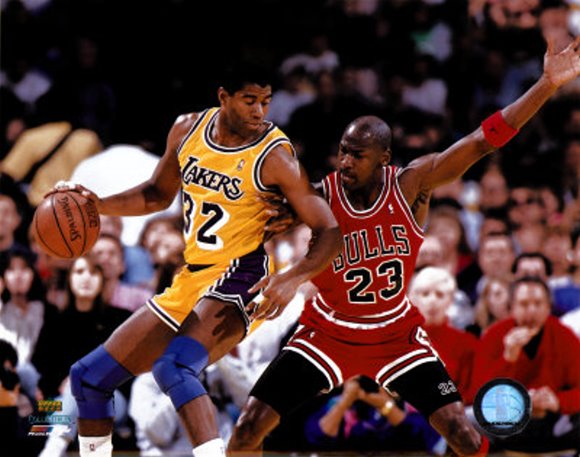
Enjoy. You earned it.
Lebron was deservedly named the NBA Finals MVP. Most importantly, at least to me, is that he played like the 6'8" 260 lbs. (at least) monster that he is. He only shot 18% from behind the 3-point line, a place he has often drifted to far too often in his career, while still managing to average nearly 30 points per game. He was outstanding in the paint, however. No one will ever confuse Lebron for Larry Bird as a jump shooter, and in previous big games he has settled far too often for jumpers, which clanked off of the rim. This year though he drive to the basket with reckless abandon, either finishing for himself or using his deft passing ability to hit the open man. Finally, James played like the amazing talent he is, and not like the player it appeared he wanted himself to be - an overgrown shooting guard. Scottie Pippen was often called a "point forward" for his ability to handle and distribute the ball. James has taken that mantra to a new level, and could rightfully be called a "power point" with his physical dominance and passing ability. Hopefully, he keeps this mindset and revolutionizes the game like Bird, Magic, Wilt and Jordan before him.
How Did Lebron's Performance Stack Up Historically?
Like many others before him, most recently Dirk Nowitzki in 2011, Lebron was able to overcome past failures in the NBA Finals (2007, 2011) to finally get one for himself. Clearly, his numbers in these NBA Finals were outstanding, but was it an all-time great performance? Here are some of the best performances of the past 20 years:
2009: Kobe Bryant won his 4th NBA title with a pretty outstanding display against the Orlando Magic, averaging 32.4 ppg, 5.6 rpg, 7.4 apg. In addition, he also averaged 1.4 blocked shots per game.
2006: Dwyane Wade, now Lebron's teammate in Miami, won his first NBA title by beating Dirk Nowitzki and the Dallas Mavericks in 6 games after falling behind 0-2. Wade was named MVP after 34.7 ppg, 7.8 rpg, 3.8 apg, and 2.7 steals per game.
2003, 1999: In 2003, Tim Duncan was named the NBA Finals MVP after posting 24.2 ppg, 17.0 rpg, 5.3 apg and a whopping 5.3 bpg against the New Jersey Nets. In 1999, while teaming with David Robinson, he averaged 27.4 ppg, 14.0 rpg, and 2.2 bpg.
2000, '01, '02: Shaquille O'Neal simply laid waste to anyone who dared guard him in the paint during the Lakers three-peat at the start of the new century, earning three consecutive Finals' MVPs along the way. In '00, O'Neal averaged 38 ppg, 16.7 rpg, 2.7 bpg while connecting on 61% of his shots from the field. The following season, he posted 33.0 ppg, 15.8 rpg, 4.8 apg, and 3.4 bpg. In 2002, he averaged 36.3 ppg, 12.3 rpg, and 2.8 bpg while once again shooting better than 60% from the field.
1995: Hakeem Olajuwon, who earned NBA Finals MVP, got the best of a young Shaquille O'Neal to the tune of 32.8 ppg, 11.5 rpg, 5.5 apg, 2.0 steals per game and 2.0 bpg. It must be noted as well that Olajuwon's Houston Rockets swept the Magic as well.
Then, of course, there was a player who never had a bad NBA Finals series....

You knew where this was heading....
In 1993, Jordan kept friend and fellow "Dream Team" teammate and future Hall of Famer Charles Barkley from winning a title by averaging 41.3 ppg, 8.5 apg, and 6.3 apg, while connecting on 50% of his field goals and 40% of his three-pointers.
Despite being the "second banana" on that team in '93, Scottie Pippen averaged 21.2 ppg, 9.2 rpg and 7.7 apg. In any other year, that would been a certain NBA Finals MVP.
Lastly, in 1997, Jordan knocked off Karl Malone and John Stockton in the first of two meetings between the Bulls and Jazz in the Finals. Jordan earned his 5th Finals MVP by scoring 32.3 ppg, 7.0 rpg and 6.0 apg.
1987: Magic Johnson lead the Lakers to the title over the Celtics, scoring 26.2 ppg, 8.0 rpg, 13.0 apg, 2.3 spg while shooting 54% from the field and 96% from the free throw line. He amazingly only committed 13 turnovers in six games compared to 78 assists.
1986: Finals MVP Larry Bird lead his Celtics over Olajuwon and the Rockets, and nearly averaged a triple double along the way - 24.0 ppg, 9.7 rpg, 9.5 apg, and 2.7 spg.


